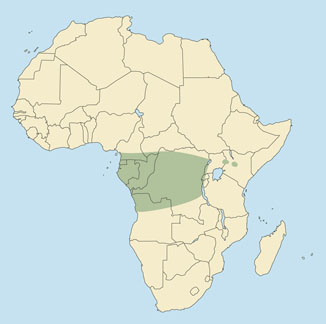 |
Cephalophus nigrifrons
Duiquer de frente negro (Sp), Schwarzstirnducker (G), Céphalophe à front noir (F).
DESCRIPTION Shoulder height 19-21 inches (48-53 cm). Weight 35-40 pounds (16-18 kg).
A medium-sized duiker with relatively long legs and a coarse coat. The general color is rich chestnut, with underparts the same or very slightly lighter. It is distinguished from other duikers by the wide black nose stripe connecting to the black forehead, and by the blackish lower legs and feet. The black facial blaze contrasts strongly with the lighter eyebrow streak and the reddish sides of the face. The well-developed head tuft is mostly black, with a few reddish hairs mixed in. The tail has a blackish tuft with a white tip. There is no dorsal stripe. The hoofs are elongated and the false hoofs are large, which are adaptations for walking on soft marshy ground. Inguinal (groin) glands are said to be present in some populations, absent in others. The horns (both sexes) are thick at the base, strongly ridged, oval in section, with very thin straight tips, and grow backward in the plane of the face. Females are similar to males, but have smaller horns.
BEHAVIOR Territorial and at least partly diurnal.
HABITAT Rain forest, including mountain rain forest, especially in marshy areas.
DISTRIBUTION Southern Cameroon; the extreme southwestern tip of the Central African Republic; possibly in Rio Muni; parts of Gabon; northern Congo (B); northern and central Congo (K) eastward to the Virunga volcanoes, where found as high as 11,500 feet (3,500 m); and the lower slopes of the Ruwenzori Mountains of northeastern Congo (K) and southwestern Uganda. Also an isolated population from 8,000-11,500 feet (2,400-3,500 m) on Mt. Elgon on the Uganda-Kenya border, and another above about 8,500 feet (2,600 m) on Mt. Kenya; on both mountains it is most common in the bamboo zone. Formerly found in the Aberdare mountains in Kenya. Also occurs in western Rwanda and northwestern Burundi.
TAXONOMIC NOTES At one time the black-fronted duiker was regarded as a race of Natal red duiker (Cephalophus natalensis), but now is considered a distinct species. Four subspecies are listed, which we do not separate: fosteri (Mt. Elgon), hooki (Mt. Kenya), kivuensis (southern Uganda, including Lake Kivu and lower slopes of the Ruwenzori Mountains), and nigrifrons (lowland forest from Cameroon to Congo [K]). Some authorities believe that the Ruwenzori red duiker (rubidus) is also a subspecies of black-fronted duiker, but for now we follow Kingdon in treating it as a full species.
|





